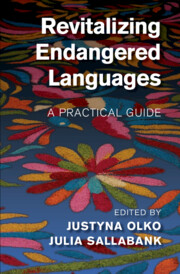We have learnt a lot from preparing this book (and from the Engaged Humanities collaborative project that motivated it). It has been inspiring to work with so many people from all over the world, and to hear their stories and their approaches to solving problems that arise. Sometimes these problems and solutions are quite specific to their cases, but often we see similar issues in different communities and language contexts. We hope that this book will inspire you too, and that the solutions and ideas discussed will help you to develop and test your own strategies.
This book has tried to focus on positive aspects of language revitalization and its complexity, in order to encourage participation. Its goal has also been to help you to deal with different facets of revitalization, which sometimes can only be done step by step, though keeping in mind other important challenges and tasks that need to follow. It is important, however, to recognize that the road may not be smooth and that problems may arise. Here we offer some tips on how to minimize their impact.
Firstly, it may not be easy. Language revitalization can take a long time – even generations. Activists can get discouraged and ‘burn out’. It helps if you can gather a group of keen people who support each other, and who share both the work and the joy of speaking their language again. It also helps to make contacts with other communities and support networks, to avoid feeling isolated. Links with academics can provide access to literature on how others have addressed problems.
Secondly, language revitalization is complex. It is not only about language: it may include many areas of life such as culture, education, politics, healthcare, environment, social and broadcast media. You will need allies with a range of expertise, e.g. project planning, fundraising and accounting, computer programming, public relations, teacher training, syllabus design, art and crafts, museum and archive curation, care for senior citizens. Not all of these people may speak or learn the language, but their support is vital and they share a commitment to supporting language revitalization.
Thirdly, disagreements are common (almost inevitable); individuals and groups may disagree on strategy and on what the language should be like. It is important to remember that language links people; we should not let it become a barrier. Remember you all have the same broad goal, and that an integrated plan needs different parts. Most importantly, you can’t afford to put anybody off – especially young people, who are the future.
Fourthly, we should keep in mind that language revitalization is – in a great majority of cases – a never-ending process. We should always plan at least one step ahead and make sure there are followers to take over the task. Even very successful language revitalization projects meet with serious challenges after generational turnover. They require constant effort to keep their languages spoken and used by the youngest generations. This is, for example, the case of the Manx language that was brought back on the Isle of Man back in the 1980s, and the revolutionary self-determination movement of the Diné/Navajo that resulted in the creation of the famous immersive community-controlled school in Rough Rock in 1966. To keep the language in use across generations, these new generations need to be attracted to and engaged in the process. Fortunately, new tools, approaches and solutions develop along the way, often through collaboration and reading books like this.
Fifthly, we have observed that language revitalization movements can get distracted by activities which are attractive and fun, but which don’t have a lot of language content. You are likely to have limited resources, both human and financial. Weigh up the usefulness and relevance of ideas, and prioritize them accordingly. Awareness raising is important, but you may be losing speakers in the meantime. It can be easier to campaign for someone else to do something, e.g. for the government to recognize your language, or for it to be taught in schools, than to change your own language practices. The heart of language revitalization is using our languages in the community, with our family and friends. If we don’t have a core of fluent speakers, we can’t provide the language needed for other activities.
Successful language revitalization therefore needs courage, perseverance and openness to new ideas. But the most important thing is: speak your language!



